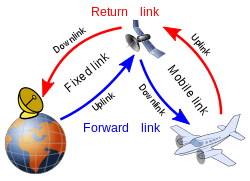Aeronautical mobile-satellite (OR) service


Aeronautical mobile-satellite (OR)°° service (short: AMS(R)S; | also: aeronautical mobile-satellite (R) radiocommunication service) is – according to Article 1.37 of the International Telecommunication Union´s (ITU) Radio Regulations (RR)[1] – defined as «An aeronautical mobile-satellite service reserved for communications relating to safety and regularity of flights, primarily outside national or international civil air routes.»
- See also
- Main articles: Radio station and Radiocommunication service
Classification
This radiocommunication service is classified in accordance with ITU Radio Regulations (article 1) as follows:
Mobile service (article 1.24)
- Aeronautical mobile service (article 1.32)
- Aeronautical mobile-satellite service (article 1.35)
- Aeronautical mobile-satellite (R)° service (article 1.36)
- Aeronautical mobile-satellite (OR)°° service (article 1.37)
- Aeronautical mobile-satellite service (article 1.35)
(R)° – abbreviation to route flights (route)
(OR)°° – abbreviation to flights others than on routs (off-route)
Frequency allocation
The allocation of radio frequencies is provided according to Article 5 of the ITU Radio Regulations (edition 2012).[2]
In order to improve harmonisation in spectrum utilisation, the majority of service-allocations stipulated in this document were incorporated in national Tables of Frequency Allocations and Utilisations which is with-in the responsibility of the appropriate national administration. The allocation might be primary, secondary, exclusive, and shared.
- primary allocation: is indicated by writing in capital letters
- secondary allocation: is indicated by small letters
- exclusive or shared utilization: is within the responsibility of administrations
References / sources
- ↑ ITU Radio Regulations, Section IV. Radio Stations and Systems – Article 1.37, definition: aeronautical mobile-satellite (OR)°° service / aeronautical mobile-satellite (OR)°° radiocommunication service
- ↑ ITU Radio Regulations, CHAPTER II – Frequencies, ARTICLE 5 Frequency allocations, Section IV – Table of Frequency Allocations